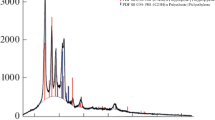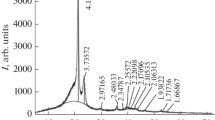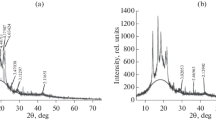Abstract
The effect of nanofiller (NF) additives containing zinc oxide nanoparticles stabilized by a polymer matrix of high pressure polyethylene obtained by the mechanochemical method on the structure and properties of metal-containing nanocomposites based on isotactic polypropylene (PP) and high pressure polyethylene (PE) using differential thermal (DTA) and X-ray phase (XRD) analyses was studied. The improvement of strength, deformation, and rheological parameters, as well as thermal-oxidative stability of the obtained nanocomposites, was revealed, which, apparently, is associated with the synergistic effect of interfacial interaction of zinc-containing nanoparticles in the PE matrix with the components of the PP/PE polymer composition. It is shown that nanocomposites based on PP/PE/NF can be processed both by the pressing method and by the injection molding and extrusion methods, which expands the scope of its application.
Similar content being viewed by others
Explore related subjects
Discover the latest articles, news and stories from top researchers in related subjects.Avoid common mistakes on your manuscript.
INTRODUCTION
It is known that, for the targeted improvement of the properties of polypropylene (PP), the modification method is widely used, which consists in the creation of polymer-polymer compositions [1].
Isotactic polypropylene (PP) is often used to create polymer-polymer compositions with improved properties on its basis. However, PP, high pressure polyethylene (PE), and many other polymers are not compatible with each other. To improve their compatibility, it is necessary to have functional groups in their composition or to introduce compatibilizers or nanofillers (NF) into the composition as interfacial additives that improve both the compatibility of the components and the operational properties of the obtained materials [2–8].
The use of dispersed nanofillers makes it possible to control the structure and properties of materials through nucleation and orientation effects, changes in the conformation of macromolecules, their chemical bonding with the surface of nanoparticles, and “healing” of structural defects [9–11].
The development of research on nanosized and cluster metal-containing particles in polymer matrices was largely facilitated by the creation of metal-polymer composite materials with specific physical, mechanical, and operational properties: increased thermal and electrical conductivity, high magnetic susceptibility, the ability to screen ionizing radiation, etc. [12, 13].
It is known that the use of nanoparticles (NPs) of d-valence metals (copper, zinc, cobalt, nickel, etc.) in polymers makes it possible to obtain fundamentally new materials that are widely used in radioelectronics and optoelectronics as magnetic, conductive, and optical media [14, 15].
The aim of this work is to study the effect of small NF additives containing NPs of metal oxides on the physicomechanical, rheological, and thermal properties of composites based on isotactic PP and PE.
EXPERIMENTAL
In this work, we used the following:
—isotactic PP Kaplen (Russia) brand 01 030 with a molecular weight of ~2–3 × 105, with a polydispersity index of 4.5, with a melt flow rate (MFR) of 2.3–3.6 g/10 min;
—high-pressure polyethylene grade 15803-020 (PE), ρ = 0.917–0.921 g cm–3, MFI 1.5–2.5 g/10 min.
As a nanofiller, we used NPs of zinc oxides stabilized by a polymer matrix of high-pressure polyethylene obtained by a mechanochemical method in a polymer melt. The content of nanoparticles was 5 wt %, the size was 39 ± 1.0 nm, and the degree of crystallinity was 35–45% [16]. The ratio of the co-mponents of the composition (in wt %) was PP/PE/NN = 50/50/(0.5, 1.0, 2.0) Nanocomposite polymer materials were obtained by mixing PP and PE with zinc-containing NF on laboratory rollers at a temperature of 160–165°C for 15 min. For mechanical tests, the resulting mixtures were pressed in the form of plates 1 mm thick at 190°C and a pressure of 10 MPa for 10 min.
The physicomechanical parameters of the obtained compositions were determined on an RMI-250 device, the melt flow rate (MFR) was obtained on a CEASTMF50 capillary rheometer manufactured by INSTRON (Italy) at a temperature of 190°C and a load of 5 kg. X-ray phase analysis (XRD) of the obtained compositions was carried out on a D2 Phaser instrument from Bruker (Germany). The thermal stability of the studied samples of nanocomposites was studied on a Q-1500D derivatograph (MOM, Hungary). The tests were carried out in an air atmosphere in a dynamic mode where the sample was heated at a rate of 5 K min–1 from 20 to 500°С, a weighed portion of 100 mg, the sensitivity of the channels of differential thermal analysis (DTA) of 250 μV, thermogravimetry (TG) of 100 mV, differential thermogravimetric analysis (DTG) of 1 mV.
RESULTS AND DISCUSSION
The effect of NF containing zinc oxide NPs on the structure of a composite based on PP/PE was investigated by the X-ray phase method. Figures 1 and 2 show the XRD patterns of the initial PP/PE and PP/PE with a zinc-containing nanofiller. Reflections corresponding to the initial PP/PE (Fig. 1) and reflections characteristic of zinc-containing nanoparticles are shown: dhkl 2.47966, 2.13735, 1.51401, 1.28859 Å (Fig. 2), which corresponds to the dhkl series of zinc oxide according to the ASTM card index. [d-Spacings (20)—01-071-3645 (Fixed Slit Intensity)—Cu Kα1 1.54056 Å. Entry Date: 11/19/2008. Last Modification Date: 01/19/2011]. Table 1 shows the physicomechanical and rheological parameters of composites based on PP/PE containing a nanofiller with zinc oxide nanoparticles.
As can be seen from the data in the Table 1, the introduction into the composition of 0.5 wt % NF leads to an increase in the strength index from 13.15 to 15.27 MPa. An increase in the concentration of NF greater than 1.0 wt % leads to a decrease in the strength of the composite (13.93 MPa), which is probably due to the aggregation of nanoparticles, which leads to the formation of microdefects in the bulk of the polymer matrix. Introduction to the composition of 0.5–1.0 wt % NF leads to an increase in the deformation value upon fracture of the composite by a factor of 1.2, which is apparently associated with the synergistic effect of the interfacial interaction of zinc-containing nanoparticles in the PE matrix with the components of the PP/PE polymer composition, the mutual influence of which contributes to an increase in both the deformation value and the strength index.
The study of the Vicat heat resistance of the obtained compositions showed that the introduction of a nanofiller into the PP/PE composition hardly affects the heat resistance index.
At the same time, an increase in the content of nanofiller (1.0–2.0 wt %) promotes an increase in the melt flow rate (MFR) to 19.7 (1.0 wt %) and 34.6 (2.0 wt %) g/10 min, which indicates an improvement in the fluidity of the composition and the possibility of processing it by injection molding and extrusion.
The thermal stability of the studied samples based on PP/PE containing NFs with zinc oxide NPs was estimated from the value of the activation energy (Eа) of thermo-oxidative destruction, calculated by the method of double logarithm of the TG curve according to the method described in [17], at a temperature of 10% (T10), 20% (T20), and 50% (T50) decay of the samples under study, as well as their half-life—τ1/2. The results of derivatographic studies are shown in Table 2.
It has been shown that the introduction of zinc oxide NPs into the composition of the compound promotes a significant increase in the decomposition temperature of the samples: T10—from 200 to 335°C, T20—from 275 to 355°C, T50—from 325 to 390°C; the half-life τ1/2 increases from 55.6 to 74.9 min; the activation energy (Eа) of thermo-oxidative destruction of the obtained nanocomposites increases from 191.4 to 248.5 kJ/mol.
As a result of derivatographic studies, it has been shown that the introduction of NF containing NPs of zinc oxides into the composition of the compound improves the thermo-oxidative stability of the obtained nanocomposites.
Numerous experimental data on the mechanical, strength, relaxation, and other properties of polymer-polymer and polymer-filler mixtures are explained within the framework of the concept of the presence of an interphase layer [18]. The properties of polymer composites are noticeably influenced by the supramolecular structure of the polymer (size of spherulites, degree of crystallinity, presence of C=O groups and various branches, etc.) and interfacial interaction at the interface [19].
The metal-containing nanoparticles used in this work, being located at the interface of the interphase layer of the structural elements of PP and PE, contribute to the formation in the melt of a composition of heterogeneous nucleation centers, which, in the process of stepwise cooling of the nanocomposite, contribute to an increase in crystallization centers, leading in general to an improvement in the crystallization process and the formation of a relatively small-spherolite structure.
The results show that small amounts of nanofiller (0.5–1.0 wt %) introduced into the polymer play the role of structure-forming agents—artificial nuclei of crystallization, which contributes to the formation in the polymer of a small-spherolite structure characterized by improved physicomechanical, rheological, and thermal properties of the obtained nanocomposite [20].
REFERENCES
Ermakov, S.N. and Kravchenko, T.P., Polymer compatibility. Thermodynamic and chemical aspects, Plast. Massy, 2012, no. 4, pp. 32–38.
Novokshonov, V.V., Musin, I.N., and Kimbel’blat, V.I., Dependence of the properties of PP/EPK mixtures on the composition and characteristics of polymers, Plast. Massy, 2009, no. 5, pp. 7–10.
Kuchmenova, L.Kh., Slonov, A.L., Zhansitov, A.A., Shelgaev, V.N., Khashirova, S.Yu., and Mikitaev, A.K., Investigation of the thermal properties of the polymer-polymeric compositions based on polypropylene, Plast. Massy, 2014, nos. 7–8, pp. 7–9.
Nigmatulina, A.I., Vol’fson, S.I., Okhotina, N.A., and Shaldybina, M.S., Properties of dynamic thermoplastic elastomers containing modified polypropylene and layered filler, Vestn. Kazansk. Tekhnol. Univ., 2010, no. 9, pp. 329–331.
Perestoronina, Z.A., Ableev, R.I., Baranets, I.V., and Kurlyand, S.K., Influence of polymer additives on the enhancement of interfacial interaction in mixed thermoplastic elastomers, Kauchuk Rezina, 2012, no. 2, pp. 13–16.
Zaikin, A.E. and Bobrov, G.B., Oil-resistant thermoplastic elastomer based on a mixture of polypropylene and a copolymer of ethylene with vinyl acetate, vulcanized by the hydrosilylation reaction, Vestn. Kazansk. Tekhnol. Univ., 2013, vol. 16, no. 2, pp. 105–108.
Kakhramanov, N.T., Guliev, A.D., and Pesetskii, S.S., Dynamically vulcanized nanocomposites based on random polypropylene, butadiene nitrile rubber and kaolin, Kompoz. Nanostruct., 2019, vol. 11, no. 4, pp. 131–136.
Sevast’yanov, D.V., Doriomedov, M.S., Daskovskii, M.I., and Skripachev, S.Yu., Single-polymer composites—classification, synthesis, mechanical properties and application (review), Tr. VIAM, 2017, no. 4, pp. 104–118.
Suzdalev, I.P. and Suzdalev, P.I., Nanoclusters and nanocluster systems. Assembling, interactions and properties, Russ. Chem. Rev., 2001, vol. 70, no. 3, pp. 177–210. https://doi.org/10.1070/RC2001v070n03ABEH000627
Mikhailin, Yu.A., Polymer nanocomposition materials, Polimer. Mater., 2009, no. 7, pp. 10–13.
Koo, J.H., Polymer Nanocomposites. Processing, Characterization and Applications, New York: McGraw-Hill, 2006.
Tret’yakov, A.O., Polymer nanocomposites – materials of XXI century, Oborud. Instrum. Profession., 2003, no. 2 (37), pp. 18–20.
Foster, L.E., Nanotechnology: Science, Innovation and Opportunity, Prentice Hall, 2005. ISBN 10:0137025750
Pomogailo, A.D., Rozenberg, A.S., and Uflyand, I.E., Nanochastitsy metallov v polimerakh (Nanoparticles of Metals in Polymers), Moscow: Khimiya, 2000.
Gubin, S.P., Yurkov, G.Yu., and Kosobudsky, I.D., Nanomaterials based on metal-containing nanoparticles in polyethylene and other carbon-chain polymers, Int. J. Mat. Prod. Technol., 2005, vol. 23, nos. 1–2, pp. 2–25.
Kurbanova, N.I., Alimirzoeva, N.A., Guseinova, Z.N., and Nurullayeva, D.R., Ecological method of preparation of metal-containing nanoparticles in polyethylene matrix, Proc. 3rd Int. Turkic World Conf. on Chemical Sciences and Technologies, Azerbaijan, Baku, September 10–13, 2017, pp. 22–24.
Kurenkov, V.F., Praktikum po khimii i fizike polimerov (Practical Work on the Chemistry and Physics of Polymers), Moscow: Khimiya, 1990.
Pomogailo, A.D., Molecular polymer–polymer compositions. Synthetic aspects, Russ. Chem. Rev., 2002, vol. 71, no. 1, pp. 1–32. https://doi.org/10.1070/RC2002v071n01ABEH000681
Kuleznev, V.N., Smesi i splavy polimerov (Mixtures and Alloys of Polymers), St. Petersburg: Nauchn. Osnovy Tekhnol., 2013.
Entsiklopediya polimerov (Encyclopedia of Polymers), Moscow: Sov. Entsiklopediya, 1974, vol. 2.
Author information
Authors and Affiliations
Corresponding author
Ethics declarations
The effect of a zinc oxide nanofiller stabilized by a high-pressure polyethylene matrix, obtained by a mechanochemical method, on the properties of composites based on PP/PE was investigated.
XRD patterns confirm the presence of zinc oxide nanoparticles in the composites based on PP/PE.
An improvement in the strength, deformation, and rheological parameters, as well as the thermal-oxidative stability of the obtained nanocomposites, has been revealed.
It is shown that nanocomposites based on PP/PE/NN can be processed both by pressing and by injection molding and extrusion.
It has been shown that it is promising to use as an additive to PP/PE a nanofiller containing NPs of zinc oxides stabilized by a matrix of high-pressure polyethylene, obtained by a mechanochemical method, which contributes to the creation of a fine-crystalline structure of the composition, in connection with which its properties are improved and, thus, the fields of application of the obtained nanocomposite are expanded.
Additional information
Translated by M. Drozdova
Rights and permissions
About this article
Cite this article
Kurbanova, N.I., Ragimova, S.K., Alimirzoeva, N.A. et al. Composites Based on Isotactic Polypropylene and High-Pressure Polyethylene with Zinc-Containing Nanofillers. Inorg. Mater. Appl. Res. 13, 485–488 (2022). https://doi.org/10.1134/S2075113322020253
Received:
Revised:
Accepted:
Published:
Issue Date:
DOI: https://doi.org/10.1134/S2075113322020253






